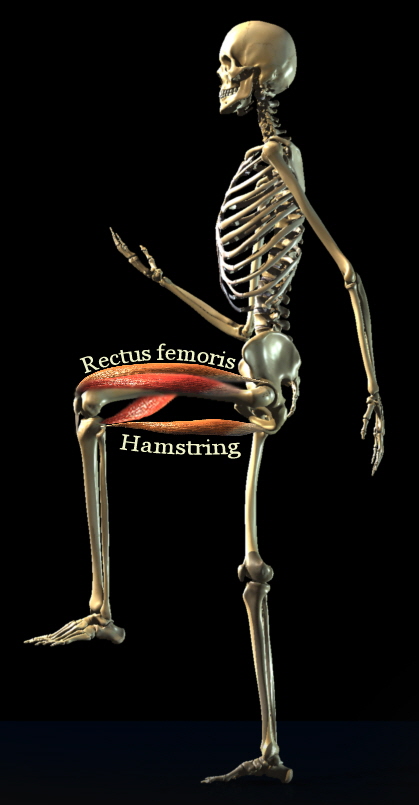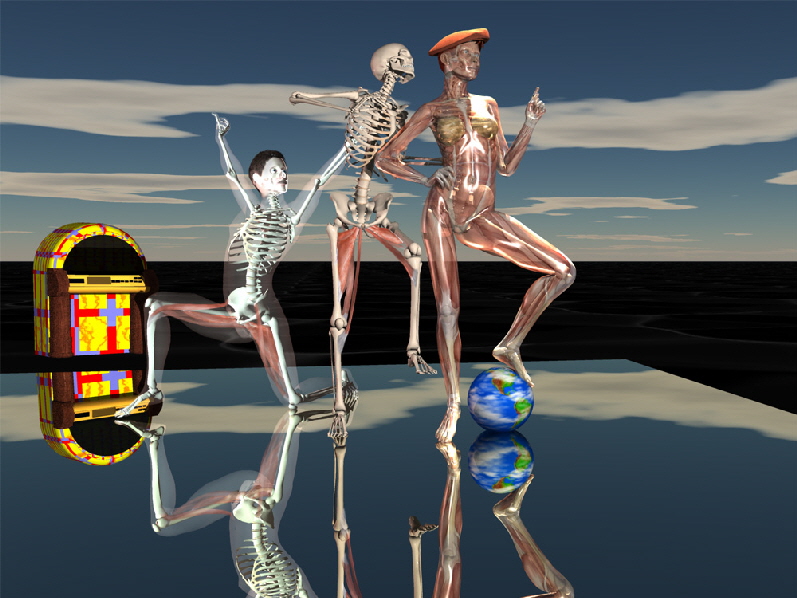|
Most of the anatomy has been covered. Here we fix on some relationships that tend to get missed in the naming of parts.
The muscles of the anterior thigh are mostly anti-gravity. The quadriceps has 3 very large muscles sharing the patella tendon which attaches on the tibial tubercle high up on
the front of the tibia. The rectus femoris sits in front on top of the center part (vastus) of the quadriceps (vastus intermedius) also sharing the patella tendon. The rectus femoris is set apart by the upper end
which attaches above the hip joint (not to the femur) to attach to the pelvis. So it can assist hip flexion. It can also get jerked on by hip extension and if neurologically too reactive it can fire not only itself
but by reflex the entire quadriceps group. That's not a very long lever arm compared to what is below. The rest of the tibia and the foot are over ten times as long. This - say - 10:1 lever produces speed but
requires power.
 So a mere 10 pounds of foot force can generate 100
pounds force against the quadriceps statically. But real force considerations include momentum and accelerations which are (according to Isaac Newton) in proportion to their square.
So a mere 10 pounds of foot force can generate 100
pounds force against the quadriceps statically. But real force considerations include momentum and accelerations which are (according to Isaac Newton) in proportion to their square.
Say what? OK, simply put, just trying to stand quickly from a squat can require >>TONS<< of extension force. You can see why that patella (a bone within the patella
tendon joining the quadriceps to the tibia) is so important as a force multiplier.
Notice that the hamstrings both extend the hip and flex the knee. The rectus femoris is the reverse - it flexes the hip and extends the knee. By graduating power forward
or back the LINKAGE of HIP AND KNEE forming a parallelogram can produce hip extension plus knee extension or the reverse hip flexion plus knee flexion with nearly no change in those muscle lengths. Just as a
parallelogram can skew one way or the other without the side changing length, this power couple allows muscles to move long levers with nearly no change in length. That
is one reason function can go on so long despite some really terrific muscle contracture.
So the parallelogram of pelvis (two points, one for RF at the anterior inferior spine just in front of the hip joint and another for hams on ishial tuberosity where you sit) and
the tibia two points has a diagonal - the femur.
Cool, huh? Who designed that? I love it. By the way, that also means that isometric muscle power - by modulating the level of oomph - can and does generate
much of the motion we often think of (wrongly) as muscles shortening and lengthening. This is also why supple response through a small arc free of reflex crazy
business interference is so important to both movement and CONTROL - fine control.
So - tah ta da dun tuh da tahhhhhhhh [fanfare] : HERE IT IS ! Hidden away in the anatomy section. The actual meaning of a
'CONTROL ARC'.
It is that arc of motion (a subset of the range of motion) that can be quickly modulated (reversed or whatever) with precision. That means reproducibility on demand. Control arcs can be quite narrow and still be effective.
Now you know why.
There is more, in a curious way. Let's take a tally of what must change length as that parallelogram shears one way or the other
and also tally what can stay the same length even though changing tension.
Must change length: 3 parts of the quadriceps - the vasti- (vastus medius, intermedius, and lateralis) and
the short head of the biceps femoris)
Could stay the same: rectus femoris, semimembranosis, semitendinosis, gracilis.
Which of the above most commonly require LENGTHENING in spasticity?
It is the rectus femoris, semimembranosis, semitendinosis, gracilis.. Oooo.
Wow, look how that sorts out. Coincidence?
While we are at it, do we really make things longer in those surgeries? With typical tendon lengthening - yes. The tendons are
cut is such a way as to elongate them (while thinning them). Here is the weird part. There are no scientific studies that show that
tendons are actually short in cerebral palsy (starting with cadaver studies, through xerography, ultrasound, and even MRI -
NOBODY has been able to document tendons as being short) . There are only two gorillas in this room and one gets blamed but keeps coming up innocent.
The other, muscle and the coat it wears (myofascia) keeps dodging blame. Why? Beats me. In fact I am not sure the actual
physical issue is always shortening as such.
The typical layout is above. One tendon goes this way <= and the other goes that way => and the part in the middle elongates
and shortens (the muscle part). What if ... WHAT IF ... THINK ABOUT THIS, what if a band of myofascia extends too far
and reaches the other tendon? It would act as a tether on the muscle, preventing ELONGATING. It could still tense and
effect change using the above stuff - linkages etc - but simply disallow lengthening. The muscle unit need not be potentially
short but more accurately 'restricted'. Like handcuffs. Is cutting the chain on hand cuffs called arm lengthening? Or freedom?
So nipping tethering myofascial bands need not produce any POTENTIAL (built in capability of) length. It my simply free it to
do what it should do. Having said that, you can cut myofascia all the way from side to side and it will slide on the muscle and
length then will be the real deal. Repeat that. Cutting ALL the myofascia can generate a whole bunch of real length. But nipping tense bits? Probably not. That is far more likely releasing constraint.
So, some fascia lengthening may indeed lengthen. The classic open myofascial methods with eponymous designations are of
that sort. But small nips here and there are not. I teach students of this method to feel for thin bands that go too far.
Whatever you do, don't shake your head or all of this will fall out.
|

